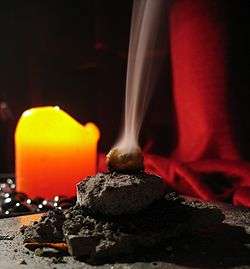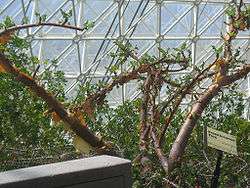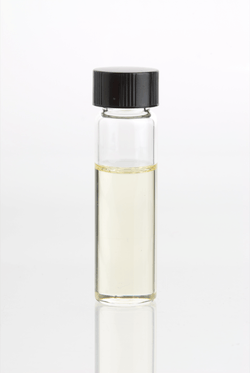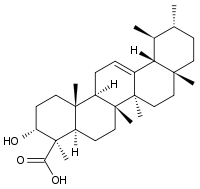Frankincense

Frankincense (also known as olibanum, Hebrew: לבונה [levona], Arabic: al-lubān) is an aromatic resin used in incense and perfumes, obtained from trees of the genus Boswellia in the family Burseraceae, particularly Boswellia sacra (syn: B. bhaw-dajiana), B. carterii33, B. frereana, B. serrata (B. thurifera, Indian frankincense), and B. papyrifera. The English word is derived from Old French "franc encens" (i.e., high quality incense).[1]
There are four main species of Boswellia that produce true frankincense. Resin from each of the four is available in various grades. The grades depend on the time of harvesting; the resin is hand-sorted for quality.
Etymology
The English word frankincense is derived from the Old French expression franc encens meaning high-quality incense. The word franc in Old French meant noble or pure.[2] A popular folk etymology is that this expression derived from the fact that the Frankish people (the forefathers of modern France and Germany) (re-)introduced the spice to Western Europe during the Middle Ages. However, though the ethnic term Frank and the generic term frank are probably related, it is nevertheless the generic term from which the word francincense in fact derives.[2][3]
The term olibanum is a Medieval Latin word that derives from the Latin expression oleum libani ("gum of francincense"). The Latin word libanus/libani in turn derives from the Greek libanos/libanotos, itself derived from a Semitic source (c.f. Arabic lubān).[4][5]
Description

Frankincense is tapped from the scraggy but hardy trees by slashing the bark, which is called striping, and allowing the exuded resin to bleed out and harden. These hardened resins are called tears. There are several species and varieties of frankincense trees, each producing a slightly different type of resin. Differences in soil and climate create even more diversity of the resin, even within the same species. Boswellia sacra trees are considered unusual for their ability to grow in environments so unforgiving that they sometimes grow out of solid rock. The initial means of attachment to the rock is unknown, but is accomplished by a bulbous disk-like swelling of the trunk. This growth prevents it from being ripped from the rock during violent storms. This feature is slight or absent in trees grown in rocky soil or gravel. The trees start producing resin when they are about eight to 10 years old.[6] Tapping is done two to three times a year with the final taps producing the best tears due to their higher aromatic terpene, sesquiterpene and diterpene content. Generally speaking, the more opaque resins are the best quality. Fine resin is produced in Somalia, from which the Roman Catholic Church purchases most of its stock.[7]
Recent studies have indicated that frankincense tree populations are declining, partly due to over-exploitation.[8] Heavily tapped trees produce seeds that germinate at only 16% while seeds of trees that had not been tapped germinate at more than 80%. In addition, burning, grazing, and attacks by the longhorn beetle have reduced the tree population.[9] Conversion (clearing) of frankincense woodlands to agriculture is also a major threat.[10]
History

Frankincense has been traded on the Arabian Peninsula, in North Africa, and Somalia for more than 5000 years.[11] [12] A mural depicting sacks of frankincense traded from the Land of Punt adorns the walls of the temple of ancient Egyptian Queen Hatshepsut, who died circa 1458 BC.[13]
Frankincense was one of the consecrated incenses (Ha-Ketoret) described in the Hebrew Bible and Talmud used in Ketoret ceremonies, an important component of the services in the Temple in Jerusalem.[14] It was offered on a specialized incense altar in the time when the Tabernacle was located in the First and Second Temples. It is mentioned in the Book of Exodus 30:34, where it is named לבונה ([levona]) (lebonah in the Biblical Hebrew), similar to the word for the color white in Hebrew, לבן ([lavan]).[14] It was one of the ingredients in the perfume of the sanctuary (Exodus 30:34), and was used as an accompaniment of the meal-offering (Leviticus 2:1, 2:16, 6:15, 24:7). It was also mentioned as a commodity in trade from Sheba (Isaiah 60:6 ; Jeremiah 6:20). When burnt it emitted a fragrant odor, and the incense was a symbol of the Divine name (Malachi 1:11 ; Song of Solomon 1:3) and an emblem of prayer (Psalm 141:2). It was often associated with myrrh (Song of Solomon 3:6, 4:6). A specially "pure" kind, lebhonah zakkah, was presented with the showbread (Leviticus 24:7).[15]
Frankincense also received numerous mentions in the New Testament (Luke 1:10 ; Revelation 5:8, 8:3). Together with myrrh, it was made an offering to the infant Jesus (Matthew 2:11).
Frankincense was reintroduced to Europe by Frankish Crusaders, although its name refers to its quality, not to the Franks themselves.[1] Although it is better known as "frankincense" to westerners, the resin is also known as olibanum, or in Arabic, al-lubān (roughly translated: "that which results from milking"), a reference to the milky sap tapped from the Boswellia tree.

The lost city of Ubar, sometimes identified with Irem in what is now the town of Shisr in Oman, is believed to have been a centre of the frankincense trade along the recently rediscovered "Incense Road". Ubar was rediscovered in the early 1990s and is now under archaeological excavation.
The Greek historian Herodotus was familiar with frankincense and knew it was harvested from trees in southern Arabia. He reported that the gum was dangerous to harvest because of venomous snakes that lived in the trees. He goes on to describe the method used by the Arabs to get around this problem, that being the burning of the gum of the styrax tree whose smoke would drive the snakes away.[16] The resin is also mentioned by Theophrastus and by Pliny the Elder in his Naturalis Historia.
Southern Arabia was a major exporter of frankincense in antiquity, with some of it being traded as far as China. The Chinese writer and customs inspector Zhao Rugua wrote on the origin of frankincense, and of its being traded to China:
"Ruxiang or xunluxiang comes from the three Dashi countries of Murbat (Maloba), Shihr (Shihe), and Dhofar (Nufa), from the depths of the remotest mountains.[17] The tree which yields this drug may generally be compared to the pine tree. Its trunk is notched with a hatchet, upon which the resin flows out, and, when hardened, turns into incense, which is gathered and made into lumps. It is transported on elephants to the Dashi (on the coast), who then load it upon their ships to exchange it for other commodities in Sanfoqi. This is the reason why it is commonly collected at and known as a product of Sanfoqi."[18]
Quality

Frankincense comes in many types, and its quality is based on color, purity, aroma, age, and shape. Silver and Hojari are generally considered the highest grades of frankincense.
Currently, there are two dissertations which may enable the identification of a few Olibanum species according to their specific secondary metabolism products.[19][20]
Production

Estimates of the current annual world production of frankincense vary, but generally are around several thousands tonnes. More than 82% of the product comes from Somalia, with some frankincense also gathered in adjacent Southern Arabia and Ethiopia, Sudan, and other central African countries.
In Somalia, frankincense is harvested in the Sanaag and Bari regions: mountains lying at the northwest of Erigavo; El Afweyn District; Cal Madow mountain range, a westerly escarpment that runs parallel to the coast; Cal Miskeed, a middle segment of the frankincense-growing escarpment; Karkaar mountains or eastern escarpment, which lies at the eastern fringe of the frankinscence escarpment.[21][8]
In Dhofar, Oman, frankincense species grow North of Salalah and were traded in the ancient coastal city of Sumhuram, now Khor Rori.
Uses
Frankincense is used in perfumery and aromatherapy. It is also an ingredient that is sometimes used in skincare. The essential oil is obtained by steam distillation of the dry resin. Some of the smells of the frankincense smoke are products of pyrolysis.
Frankincense is used in many Christian churches including the Eastern Orthodox, Oriental Orthodox and Catholic churches. According to the legend of Matthew 2:11, gold, frankincense, and myrrh were among the gifts to Jesus by the biblical magi "from out of the East." Christian and Islamic Abrahamic faiths have all used frankincense mixed with oils to anoint newborn infants, initiates and members entering into new phases of their spiritual lives.
Conversely, the spread of Christianity depressed the market for frankincense during the 4th century AD. Desertification made the caravan routes across the Rub' al Khali or "Empty Quarter" of the Arabian Peninsula more difficult. Additionally, increased raiding by the Parthians in the Near East caused the frankincense trade to dry up after A.D. 300.
Traditional medicine

Frankincense resin is edible and is used in traditional medicines in Africa and Asia for digestion and healthy skin. For internal consumption, it is recommended that frankincense be translucent, with no black or brown impurities. It is often light yellow with a (very) slight greenish tint. It is often chewed like gum, but it is stickier.
In Ayurvedic medicine frankincense (Boswellia serrata), commonly referred to in India as "dhoop," has been used for hundreds of years for treating arthritis, healing wounds, strengthening the female hormone system and purifying the air. The use of frankincense in Ayurveda is called "dhoopan". In Somali, Ethiopian, Arabian, and Indian cultures, it is suggested that burning frankincense daily in the house brings good health.[22]
Frankincense oil can also be used for relief from stings such as scorpion stings.
Frankincense essential oil

The essential oil of frankincense is produced by steam distillation of the tree resin. The oil's chemical components are 75% monoterpenes, sesquiterpenes, monoterpenoles, sesquiterpenols and ketones. It has a good balsamic sweet fragrance, while the Indian frankincense oil has a very fresh smell. Contrary to what some commercial entities claim, steam or hydro distilled frankincense oils do not contain boswellic acids (triterpenoids), although may be present in trace quantities in the solvent extracted products. The chemistry of the essential oil is mainly monoterpenes and sesquiterpenes, such as alpha-pinene, Limonene, alpha-Thujene, and beta-Pinene with small amounts of diterpenoid components being the upper limit in terms of molecular weight.[23][24][25][26][27]
Perfume
Olibanum is characterised by a balsamic-spicy, slightly lemon, fragrance of incense, with a conifer-like undertone. It is used in the perfume, cosmetic and pharmaceutical industries.
Medical research
For therapy trials in ulcerative colitis, asthma and rheumatoid arthritis there are only isolated reports and pilot studies from which there is not yet sufficient evidence of safety and efficacy. Similarly, the long-term effects and side effects of taking frankincense have not yet been scientifically investigated. Nonetheless, several preliminary studies have been published.

A 2008 study reported that frankincense smoke was a psychoactive drug that relieves depression and anxiety in mice.[28][29] The researchers found that the chemical compound incensole acetate[30] was responsible for the effects.[28]
In a different study, an enriched extract of "Indian Frankincense" (usually Boswellia serrata) was used in a randomized, double-blinded, placebo-controlled study of patients with osteoarthritis. Patients receiving the extract showed significant improvement in their arthritis in as little as seven days. The compound caused no major adverse effects and, according to the study authors, is safe for human consumption and long-term use.[31]
In a study published in 2009, it was reported that "Frankincense oil appears to distinguish cancerous from normal bladder cells and suppress cancer cell viability."[32]
A 2012 study in healthy volunteers determined that exposure to 11-keto-β-boswellic acid (KBA), a lead boswellic acid in the novel solubilized frankincense extract Boswelan, is increased when taken with food. However, simulations based on a two-compartment pharmacokinetic model with single first-order absorption phase proposed that the observed food interaction loses its relevance for the simulated repeated-dose scenario.[33]
In a 2012 study, researchers found that the "behavioral effect [of insensole actetate] was concomitant to reduced serum corticosterone levels, dose-dependent down-regulation of corticotropin releasing factor and up-regulation of brain derived neurotrophic factor transcripts IV and VI expression in the hippocampus. These data suggest that IA modulates the hypothalamic–pituitary–adrenal (HPA) axis and influences hippocampal gene expression, leading to beneficial behavioral effects supporting its potential as a novel treatment of depressive-like disorders."[34]
In study published in 2014, researchers found "the effects of frankincense and sandalwood essential oils on J82 cells and UROtsa cells involved different mechanisms leading to cancer cell death. While frankincense essential oil elicited selective cancer cell death via NRF-2-mediated oxidative stress, sandalwood essential oil induced non-selective cell death via DNA damage and cell cycle arrest."[35]
Chemical composition

These are some of the chemical compounds present in frankincense:
- "acid resin (56 %), soluble in alcohol and having the formula C20H32O4"[36]
- gum (similar to gum arabic) 30–36%[36]
- 3-acetyl-beta-boswellic acid (Boswellia sacra)[37]
- alpha-boswellic acid (Boswellia sacra)[37]
- 4-O-methyl-glucuronic acid (Boswellia sacra)[37]
- incensole acetate, C21H34O3[38]
- phellandrene[36]
- (+)-cis- and (+)-trans-olibanic acids[39]
See also for example the following references which give a comprehensive overview on the chemical compounds present in different frankincense species:.[19][20]
See also
Notes
- 1 2 Oxford English Dictionary.
- 1 2 "Frankincense". Etymology Online. Retrieved 30 May 2017.
- ↑ "Frank". Etymology Online. Retrieved 30 May 2017.
- ↑ Rawlinson, George (1862). History of Herodotus. 2. London: John Murray. p. 414.
- ↑ Kogan, L. (2006). Babel Und Bibel: Annual of Ancient Near Eastern, Old Testament, and Semitic Studies, 3 (Orientalia Et Classica). Eisenbrauns. p. 188.
- ↑ "Omani World Heritage Sites". www.omanwhs.gov.om. Retrieved 2009-01-14.
- ↑ BBC.co.uk
- 1 2 Patinkin, Jason (25 December 2016). "World's last wild frankincense forests are under threat". Yahoo Finance. Associated Press. Retrieved 25 December 2016.
- ↑ Melina, Remy (December 21, 2011). "Christmas Staple Frankincense 'Doomed,' Ecologists Warn". LiveScience.
- ↑ Dejenea, T.; Lemenih, M.; Bongers, F. (February 2013). "Manage or convert Boswellia woodlands? Can frankincense production payoff?". Journal of Arid Environments. 89: 77–83. doi:10.1016/j.jaridenv.2012.09.010.
- ↑ Paper on Chemical Composition of Frankincense
- ↑ Ulric Killion, A Modern Chinese Journey to the West: Economic Globalisation And Dualism, (Nova Science Publishers: 2006), p.66
- ↑ "Queen Hatshepsut's expedition to the Land of Punt: The first oceanographic cruise?". Dept. of Oceanography, Texas A&M University. Retrieved 2010-05-08.
- 1 2 Klein, Ernest, A Comprehensive Etymological Dictionary of the Hebrew Language for Readers of English, The University of Haifa, Carta, Jerusalem, p.292
- ↑ "www.Bibler.org - Dictionary - Frankincense". 2012-07-21.
- ↑ Herodotus 3,107
- ↑ Kauz, Ralph (2010). Ralph Kauz, ed. Aspects of the Maritime Silk Road: From the Persian Gulf to the East China Sea. Volume 10 of East Asian Economic and Socio-cultural Studies - East Asian Maritime History. Otto Harrassowitz Verlag. p. 130. ISBN 3-447-06103-0. Retrieved December 26, 2011.
The frankincense was first collected in the Hadhramaut ports of Mirbat, Shihr, and Zufar whence Arab merchant vessels shipped it to Srivijaya, before it was then reexported to China. The term "xunluxiang" is derived from the Arab word "kundur". . . According to Li Xun, frankincense originally came from Persia.92 Laufer refers to the Xiangpu 香譜 by Hong Chu . . . Zhao Rugua notes: Ruxiang or xunluxiang comes from the three Dashi countries of Murbat (Maloba), Shihr (Shihe), and Dhofar (Nufa), from the depths of the remotest mountains. The tree which yields this drug may generally be compared to the pine tree. Its trunk is notched with a hatchet, upon which the
- ↑ Kauz, Ralph (2010). Ralph Kauz, ed. Aspects of the Maritime Silk Road: From the Persian Gulf to the East China Sea. Volume 10 of East Asian Economic and Socio-cultural Studies - East Asian Maritime History. Otto Harrassowitz Verlag. p. 131. ISBN 3-447-06103-0. Retrieved December 26, 2011.
resin flows out, and, when hardened, turns into incense, which is gathered and made into lumps. It is transported on elephants to the Dashi (on the coast), who then load it upon their ships to exchange it for other commodities in Sanfoqi. This is the reason why it is commonly collected at and known as a product of Sanfoqi.94
- 1 2 Chemotaxonomic Investigations on Resins of the Frankincense Species Boswellia papyrifera, Boswellia serrata and Boswellia sacra, respectively, Boswellia carterii: A Qualitative and Quantitative Approach by Chromatographic and Spectroscopic Methodology, Paul, M., Dissertation, Saarland University (2012) http://scidok.sulb.uni-saarland.de/volltexte/2012/4999/pdf/Dissertation_Fertig_211112.pdf
- 1 2 Phytochemical Investigations on Boswellia Species, Basar, S., Dissertation, Hamburg University (2005) http://www.chemie.uni-hamburg.de/bibliothek/2005/DissertationBasar.pdf
- ↑ Programme, author, War-Torn Societies Project International, Somali (2001). Rebuilding Somalia : issues and possibilities for Puntland. London: HAAN. p. 124. ISBN 1874209049.
- ↑ "Joint relief". www.herbcompanion.com. Retrieved 2009-01-12.
- ↑ Verghese, J.; et al. (1987). "A Fresh Look at the Constituents of Indian Olibanum Oil". Flav. Fragr. J. 2 (3): 99–102. doi:10.1002/ffj.2730020304.
- ↑ Hayashi, S.; Amemori, H.; Kameoka, H.; Hanafusa, M.; Furukawa, K. (1998). "Comparison of Volatile Compounds from Olibanum from Various Countries". J. Essent. Oil Res. 10: 25–30. doi:10.1080/10412905.1998.9700833.
- ↑ Baser, S., Koch, A., Konig, W.A. (2001). "A Verticillane-type diterpene from Boswellia carterii Essential Oil". Flav. Frag" J 16, 315-318
- ↑ Frank, A; Unger, M. (Apr 2006). "Analysis of frankincense from various Boswellia species with inhibitory activity on human drug metabolising cytochrome P450 enzymes using liquid chromatography mass spectrometry after automated on-line extraction". J Chromatogr A. 1112 (1-2): 255–62. doi:10.1016/j.chroma.2005.11.116.
- ↑ "Frankincense Oil and Uses".
- 1 2 Moussaieff, Arieh; Rimmerman, Neta; Bregman, Tatiana; Straiker, Alex; Felder, Christian C.; Shoham, Shai; Kashman, Yoel; Huang, Susan M.; Lee, Hyosang; Shohami, Esther; Mackie, Ken; Caterina, Michael J.; Walker, J. Michael; Fride, Ester; Mechoulam, Raphael (August 2008). "Incensole acetate, an incense component, elicits psychoactivity by activating TRPV3 channels in the brain". The FASEB Journal. 22 (8): 3024–3034. PMC 2493463
 . PMID 18492727. doi:10.1096/fj.07-101865.
. PMID 18492727. doi:10.1096/fj.07-101865. - ↑ Moussaieff, A; Gross, M; Nesher, E; Tikhonov, T; Yadid, G; Pinhasov, A (2012). "Incensole acetate reduces depressive-like behavior and modulates hippocampal BDNF and CRF expression of submissive animals". J Psychopharmacol. 26 (12): 1584–93. PMID 23015543. doi:10.1177/0269881112458729.
- ↑ Drahl, Carmen (22 December 2008). "Frankincense And Myrrh". Chemical & Engineering News. 86 (51): 38. ISSN 0009-2347. doi:10.1021/cen-v086n051.p038.
- ↑ "A double blind, randomized, placebo controlled study of the efficacy and safety of 5-Loxin for treatment of osteoarthritis of the knee". Arthritis Research & Therapy. Retrieved 2008-10-09.
- ↑ Frank, MB; Yang, Q; Osban, J; Azzarello, JT; Saban, MR; Saban, R; Ashley, RA; Welter, JC; Fung, KM; Lin, HK (2009). "Frankincense oil derived from Boswellia carteri induces tumor cell specific cytotoxicity.". BMC Complement Altern Med. 9: 6. PMC 2664784
 . PMID 19296830. doi:10.1186/1472-6882-9-6.
. PMID 19296830. doi:10.1186/1472-6882-9-6. - ↑ Skarke, Carsten; et al. (October 2012). "Increased bioavailability of 11-keto-β-boswellic acid following single oral dose frankincense extract administration after a standardized meal in healthy male volunteers: modeling and simulation considerations for evaluating drug exposures.". J Clin Pharmacol. 52 (10): 1592–1600. PMID 22167571. doi:10.1177/0091270011422811.
- ↑ Moussaieff, Arieh; Gross, Moshe; Nesher, Elimelech; Tikhonov, Tatiana; Yadid, Gal; Pinhasov, Albert (December 2012). "Incensole acetate reduces depressive-like behavior and modulates hippocampal BDNF and CRF expression of submissive animals". Journal of Psychopharmacology. 26 (12): 1584–93. PMID 23015543. doi:10.1177/0269881112458729.
- ↑ Dozmorov, Mikhail G; Yang, Qing; Wu, Weijuan; Wren, Jonathan; Suhail, Mahmoud M; Woolley, Cole L; Young, D Gary; Fung, Kar-Ming; Lin, Hsueh-Kung (2014-07-02). "Differential effects of selective frankincense (Ru Xiang) essential oil versus non-selective sandalwood (Tan Xiang) essential oil on cultured bladder cancer cells: a microarray and bioinformatics study". Chinese Medicine. 9: 18. ISSN 1749-8546. PMC 4086286
 . PMID 25006348. doi:10.1186/1749-8546-9-18.
. PMID 25006348. doi:10.1186/1749-8546-9-18. - 1 2 3 "Olibanum.—Frankincense.". Henriette's Herbal Homepage. www.henriettes-herb.com. Retrieved 2009-01-14.
- 1 2 3 "Farmacy Query". www.ars-grin.gov. Retrieved 2009-01-14.
- ↑ Incensole acetate (@NIST)
- ↑ Cerutti-Delasalle, Celine (4 October 2016). "The (+)-cis- and (+)-trans-Olibanic Acids: Key Odorants of Frankincense". Angewandte Chemie. ISSN 1521-3773. doi:10.1002/anie.201605242.
References
- Woolley, CL; et al. (Oct 2012). "Chemical differentiation of Boswellia sacra and Boswellia carterii essential oils by gas chromatography and chiral gas chromatography-mass spectrometry". Journal of Chromatography A. 1261: 158–63. doi:10.1016/j.chroma.2012.06.073.
- Bibliography
- Müller, Walter W.: Weihrauch : ein arabisches Produkt und seine Bedeutung in der Antike, Realencyclopaedie / Pauly-Wissowa : Supp. ; 15, 1978, 700-777.
- Groom, Nigel (1981). Frankincense & Myrrh: A Study of the Arabian Incense Trade. ISBN 0-86685-593-9.
- Maloney, George A, (1997). Gold, Frankincense, and Myrrh: An Introduction to Eastern Christian Spirituality. ISBN 0-8245-1616-8.
External links
| Wikimedia Commons has media related to Frankincense. |
 Quotations related to Frankincense at Wikiquote
Quotations related to Frankincense at Wikiquote "Frankincense". Encyclopædia Britannica. 11 (11th ed.). 1911.
"Frankincense". Encyclopædia Britannica. 11 (11th ed.). 1911.
.jpg)
.jpg)